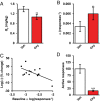Economic demand predicts addiction-like behavior and therapeutic efficacy of oxytocin in the rat
- PMID: 25071176
- PMCID: PMC4136574
- DOI: 10.1073/pnas.1406324111
Economic demand predicts addiction-like behavior and therapeutic efficacy of oxytocin in the rat
Abstract
Development of new treatments for drug addiction will depend on high-throughput screening in animal models. However, an addiction biomarker fit for rapid testing, and useful in both humans and animals, is not currently available. Economic models are promising candidates. They offer a structured quantitative approach to modeling behavior that is mathematically identical across species, and accruing evidence indicates economic-based descriptors of human behavior may be particularly useful biomarkers of addiction severity. However, economic demand has not yet been established as a biomarker of addiction-like behavior in animals, an essential final step in linking animal and human studies of addiction through economic models. We recently developed a mathematical approach for rapidly modeling economic demand in rats trained to self-administer cocaine. We show here that economic demand, as both a spontaneous trait and induced state, predicts addiction-like behavior, including relapse propensity, drug seeking in abstinence, and compulsive (punished) drug taking. These findings confirm economic demand as a biomarker of addiction-like behavior in rats. They also support the view that excessive motivation plays an important role in addiction while extending the idea that drug dependence represents a shift from initially recreational to compulsive drug use. Finally, we found that economic demand for cocaine predicted the efficacy of a promising pharmacotherapy (oxytocin) in attenuating cocaine-seeking behaviors across individuals, demonstrating that economic measures may be used to rapidly identify the clinical utility of prospective addiction treatments.
Keywords: behavioral economics; extinction; long access; punished responding; reinstatement.
Conflict of interest statement
The authors declare no conflict of interest.
Figures




References
-
- Becker RE, Greig NH. 2010. Lost in translation: Neuropsychiatric drug development. Sci Transl Med 2(61):61rv6.
Publication types
MeSH terms
Substances
Grants and funding
LinkOut - more resources
Full Text Sources
Other Literature Sources
Medical

